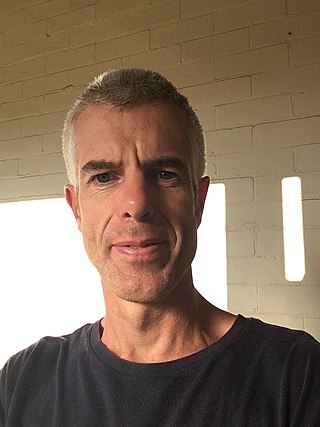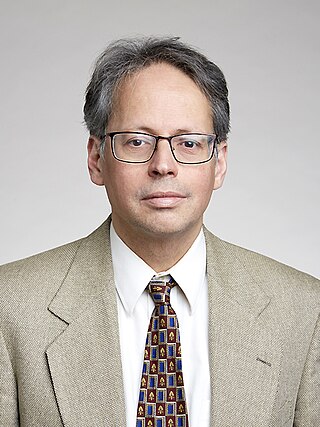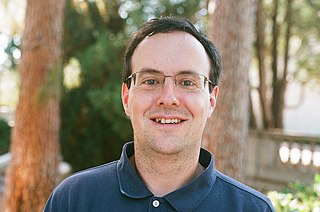In mathematics, complex geometry is the study of geometric structures and constructions arising out of, or described by, the complex numbers. In particular, complex geometry is concerned with the study of spaces such as complex manifolds and complex algebraic varieties, functions of several complex variables, and holomorphic constructions such as holomorphic vector bundles and coherent sheaves. Application of transcendental methods to algebraic geometry falls in this category, together with more geometric aspects of complex analysis.

In algebraic and differential geometry, a Calabi–Yau manifold, also known as a Calabi–Yau space, is a particular type of manifold which has certain properties, such as Ricci flatness, yielding applications in theoretical physics. Particularly in superstring theory, the extra dimensions of spacetime are sometimes conjectured to take the form of a 6-dimensional Calabi–Yau manifold, which led to the idea of mirror symmetry. Their name was coined by Candelas et al. (1985), after Eugenio Calabi who first conjectured that such surfaces might exist, and Shing-Tung Yau who proved the Calabi conjecture.

In mathematics, a complex analytic K3 surface is a compact connected complex manifold of dimension 2 with а trivial canonical bundle and irregularity zero. An (algebraic) K3 surface over any field means a smooth proper geometrically connected algebraic surface that satisfies the same conditions. In the Enriques–Kodaira classification of surfaces, K3 surfaces form one of the four classes of minimal surfaces of Kodaira dimension zero. A simple example is the Fermat quartic surface
In differential geometry, a hyperkähler manifold is a Riemannian manifold endowed with three integrable almost complex structures that are Kähler with respect to the Riemannian metric and satisfy the quaternionic relations . In particular, it is a hypercomplex manifold. All hyperkähler manifolds are Ricci-flat and are thus Calabi–Yau manifolds.

Nigel James Hitchin FRS is a British mathematician working in the fields of differential geometry, gauge theory, algebraic geometry, and mathematical physics. He is a Professor Emeritus of Mathematics at the University of Oxford.
In mathematics, the Torelli theorem, named after Ruggiero Torelli, is a classical result of algebraic geometry over the complex number field, stating that a non-singular projective algebraic curve (compact Riemann surface) C is determined by its Jacobian variety J(C), when the latter is given in the form of a principally polarized abelian variety. In other words, the complex torus J(C), with certain 'markings', is enough to recover C. The same statement holds over any algebraically closed field. From more precise information on the constructed isomorphism of the curves it follows that if the canonically principally polarized Jacobian varieties of curves of genus are k-isomorphic for k any perfect field, so are the curves.
In differential geometry, a hypercomplex manifold is a manifold with the tangent bundle equipped with an action by the algebra of quaternions in such a way that the quaternions define integrable almost complex structures.
John Willard Morgan is an American mathematician known for his contributions to topology and geometry. He is a Professor Emeritus at Columbia University and a member of the Simons Center for Geometry and Physics at Stony Brook University.

Fedor Alekseyevich Bogomolov is a Russian and American mathematician, known for his research in algebraic geometry and number theory. Bogomolov worked at the Steklov Institute in Moscow before he became a professor at the Courant Institute in New York. He is most famous for his pioneering work on hyperkähler manifolds.
In mathematics, a stable vector bundle is a vector bundle that is stable in the sense of geometric invariant theory. Any holomorphic vector bundle may be built from stable ones using Harder–Narasimhan filtration. Stable bundles were defined by David Mumford in Mumford (1963) and later built upon by David Gieseker, Fedor Bogomolov, Thomas Bridgeland and many others.

Thomas Andrew Bridgeland is a Professor of Mathematics at the University of Sheffield. He was a senior research fellow in 2011–2013 at All Souls College, Oxford and, since 2013, remains as a Quondam Fellow. He is most well-known for defining Bridgeland stability conditions on triangulated categories.
In mathematics, specifically algebraic geometry, Donaldson–Thomas theory is the theory of Donaldson–Thomas invariants. Given a compact moduli space of sheaves on a Calabi–Yau threefold, its Donaldson–Thomas invariant is the virtual number of its points, i.e., the integral of the cohomology class 1 against the virtual fundamental class. The Donaldson–Thomas invariant is a holomorphic analogue of the Casson invariant. The invariants were introduced by Simon Donaldson and Richard Thomas. Donaldson–Thomas invariants have close connections to Gromov–Witten invariants of algebraic three-folds and the theory of stable pairs due to Rahul Pandharipande and Thomas.

Richard Paul Winsley Thomas is a British mathematician working in several areas of geometry. He is a professor at Imperial College London. He studies moduli problems in algebraic geometry, and ‘mirror symmetry’—a phenomenon in pure mathematics predicted by string theory in theoretical physics.
In differential geometry, algebraic geometry, and gauge theory, the Kobayashi–Hitchin correspondence relates stable vector bundles over a complex manifold to Einstein–Hermitian vector bundles. The correspondence is named after Shoshichi Kobayashi and Nigel Hitchin, who independently conjectured in the 1980s that the moduli spaces of stable vector bundles and Einstein–Hermitian vector bundles over a complex manifold were essentially the same.

Kenji Ueno is a Japanese mathematician, specializing in algebraic geometry.

Klaus Hulek is a German mathematician, known for his work in algebraic geometry and in particular, his work on moduli spaces.

Mark William Gross is an American mathematician, specializing in differential geometry, algebraic geometry, and mirror symmetry.
Paul Stephen Aspinwall is a British theoretical physicist and mathematician, who works on string theory and also algebraic geometry.

Mihnea Popa is a Romanian-American mathematician at Harvard University, specializing in algebraic geometry. He is known for his work on complex birational geometry, Hodge theory, abelian varieties, and vector bundles.

Denis Auroux is a French mathematician working in geometry and topology.











